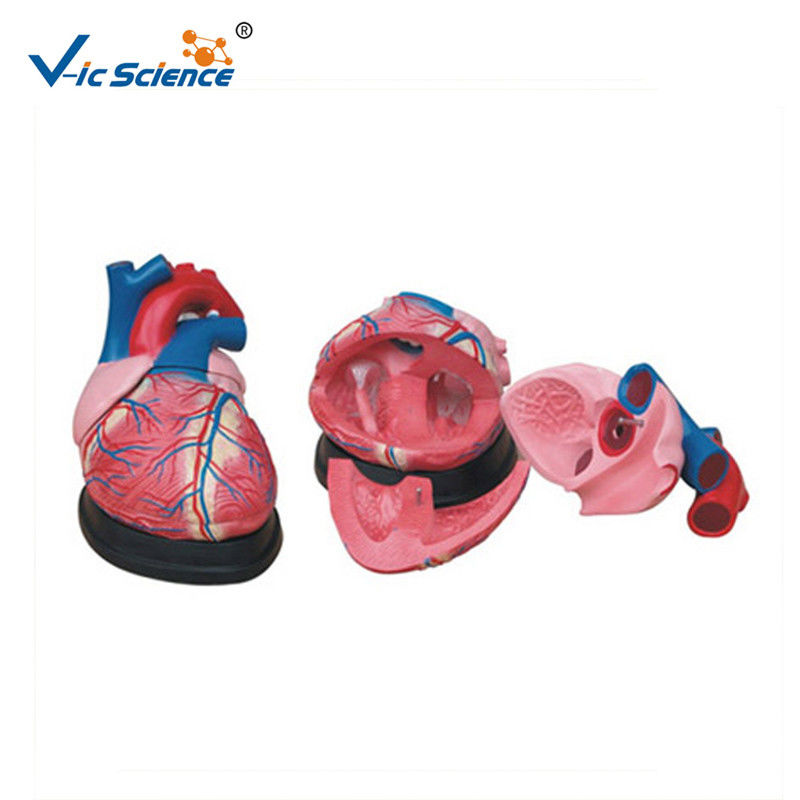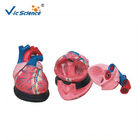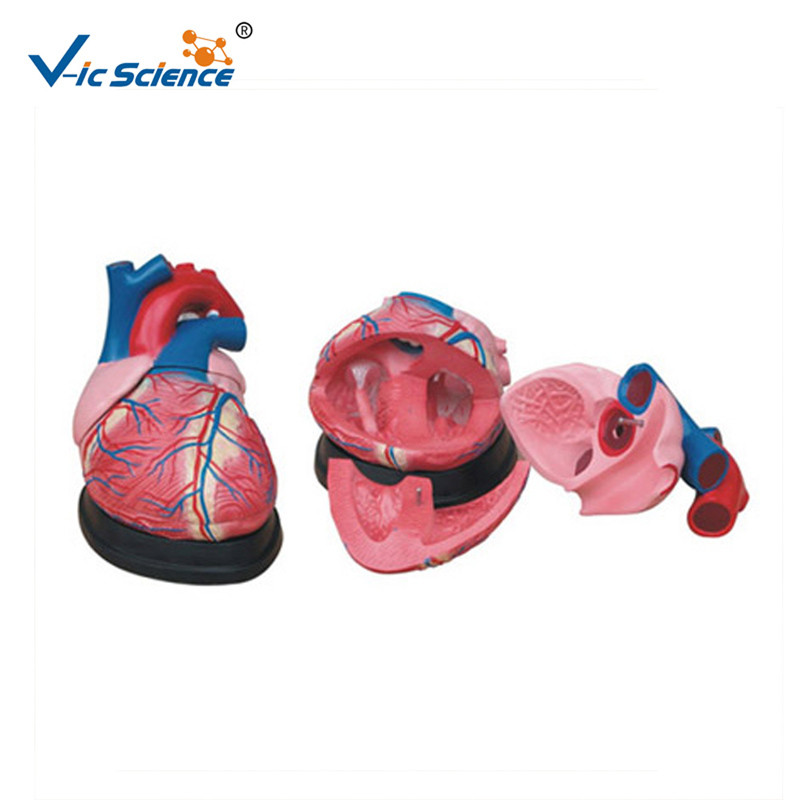|
เกี่ยวกับความรู้เกี่ยวกับหัวใจ
The heart is a muscular organ in most animals, which pumps blood through the blood vessels of the circulatory system. หัวใจเป็นอวัยวะที่มีกล้ามเนื้อในสัตว์ส่วนใหญ่ซึ่งสูบฉีดเลือดผ่านหลอดเลือดของระบบไหลเวียนเลือด Blood provides the body with oxygen and nutrients, as well as assisting in the removal of metabolic wastes. เลือดให้ออกซิเจนและสารอาหารแก่ร่างกายรวมทั้งช่วยในการกำจัดของเสียจากการเผาผลาญ In humans, the heart is located between the lungs, in the middle compartment of the chest. ในมนุษย์หัวใจตั้งอยู่ระหว่างปอดในช่องกลางของหน้าอก
In humans, other mammals, and birds, the heart is divided into four chambers: upper left and right atria and lower left and right ventricles.Commonly the right atrium and ventricle are referred together as the right heart and their left counterparts as the left heart. ในมนุษย์สัตว์เลี้ยงลูกด้วยนมอื่น ๆ และนกหัวใจแบ่งออกเป็นสี่ห้อง: บนซ้ายและขวา atria และช่องซ้ายและขวาล่างส่วนใหญ่เอเทรียมขวาและ ventricle เรียกว่าหัวใจด้านขวาและคู่ซ้ายของพวกเขาเป็นหัวใจซ้าย . Fish, in contrast, have two chambers, an atrium and a ventricle, while reptiles have three chambers. ในทางตรงกันข้ามปลามีห้องสองห้องห้องโถงใหญ่และช่องล่างในขณะที่สัตว์เลื้อยคลานมีห้องสามห้อง In a healthy heart blood flows one way through the heart due to heart valves, which prevent backflow. ในเลือดหัวใจที่แข็งแรงไหลทางเดียวผ่านหัวใจเนื่องจากลิ้นหัวใจซึ่งป้องกันการไหลย้อนกลับ The heart is enclosed in a protective sac, the pericardium, which also contains a small amount of fluid. หัวใจถูกปิดล้อมในถุงป้องกันเยื่อหุ้มหัวใจซึ่งยังมีของเหลวจำนวนเล็กน้อย The wall of the heart is made up of three layers: epicardium, myocardium, and endocardium. ผนังของหัวใจประกอบด้วยสามชั้น: epicardium, myocardium และ endocardium
The heart pumps blood with a rhythm determined by a group of pacemaking cells in the sinoatrial node. หัวใจสูบฉีดโลหิตด้วยจังหวะที่กำหนดโดยกลุ่มของเซลล์กระตุ้นความรู้สึกในโหนด sinoatrial These generate a current that causes contraction of the heart, traveling through the atrioventricular node and along the conduction system of the heart. สิ่งเหล่านี้สร้างกระแสที่ทำให้เกิดการหดตัวของหัวใจเดินทางผ่านโหนด atrioventricular และตามระบบการนำความร้อนของหัวใจ The heart receives blood low in oxygen from the systemic circulation, which enters the right atrium from the superior and inferior venae cavae and passes to the right ventricle. หัวใจได้รับเลือดต่ำในออกซิเจนจากการไหลเวียนของระบบซึ่งเข้าสู่ห้องโถงด้านขวาจาก venae cavae ที่เหนือกว่าและด้อยกว่าและผ่านไปยังช่องที่ถูกต้อง From here it is pumped into the pulmonary circulation, through the lungs where it receives oxygen and gives off carbon dioxide. จากที่นี่จะถูกสูบเข้าสู่ระบบหมุนเวียนของปอดผ่านปอดซึ่งรับออกซิเจนและปล่อยก๊าซคาร์บอนไดออกไซด์ Oxygenated blood then returns to the left atrium, passes through the left ventricle and is pumped out through the aorta to the systemic circulation−where the oxygen is used and metabolized to carbon dioxide. ออกซิเจนในเลือดจะกลับไปที่เอเทรียมซ้ายผ่านช่องทางซ้ายและสูบฉีดผ่านหลอดเลือดแดงใหญ่ไปยังระบบไหลเวียนเลือดซึ่งออกซิเจนจะถูกใช้และเผาผลาญเป็นคาร์บอนไดออกไซด์ The heart beats at a resting rate close to 72 beats per minute. หัวใจเต้นในอัตราพักผ่อนใกล้ 72 ครั้งต่อนาที Exercise temporarily increases the rate, but lowers resting heart rate in the long term, and is good for heart health. การออกกำลังกายเพิ่มอัตราชั่วคราว แต่ลดอัตราการเต้นของหัวใจในระยะยาวและเป็นผลดีต่อสุขภาพของหัวใจ

โครงสร้าง
The human heart is situated in the middle mediastinum, at the level of thoracic vertebrae T5-T8. หัวใจมนุษย์ตั้งอยู่ในกลางประจันที่ระดับของทรวงอกกระดูกสันหลัง T5-T8 A double-membraned sac called the pericardium surrounds the heart and attaches to the mediastinum. ถุงเยื่อสองชั้นที่เรียกว่าเยื่อหุ้มหัวใจรอบหัวใจและยึดติดกับเมดิแอสตินัม The back surface of the heart lies near the vertebral column, and the front surface sits behind the sternum and rib cartilages. พื้นผิวด้านหลังของหัวใจอยู่ใกล้กับกระดูกสันหลังและพื้นผิวด้านหน้าตั้งอยู่ด้านหลังกระดูกอกและกระดูกอ่อนซี่โครง The upper part of the heart is the attachment point for several large blood vessels—the venae cavae, aorta and pulmonary trunk. ส่วนบนของหัวใจเป็นจุดเชื่อมต่อของเส้นเลือดใหญ่หลายเส้น ได้แก่ เส้นเลือดฝอย, หลอดเลือดแดงใหญ่และลำตัวปอด The upper part of the heart is located at the level of the third costal cartilage. ส่วนบนของหัวใจตั้งอยู่ที่ระดับกระดูกอ่อนกระดูกซี่โครงที่สาม The lower tip of the heart, the apex, lies to the left of the sternum (8 to 9 cm from the midsternal line) between the junction of the fourth and fifth ribs near their articulation with the costal cartilages. ส่วนล่างสุดของหัวใจนั้นตั้งอยู่ทางด้านซ้ายของกระดูกอก (8 ถึง 9 ซม. จากเส้นกลาง) ระหว่างทางแยกของกระดูกซี่โครงที่สี่และห้าใกล้กับกระดูกซี่โครงกระดูกอ่อน
The largest part of the heart is usually slightly offset to the left side of the chest (though occasionally it may be offset to the right) and is felt to be on the left because the left heart is stronger and larger, since it pumps to all body parts. ส่วนที่ใหญ่ที่สุดของหัวใจมักจะถูกชดเชยเล็กน้อยที่ด้านซ้ายของหน้าอก (แม้ว่าบางครั้งมันอาจจะถูกชดเชยไปทางขวา) และรู้สึกว่าจะอยู่ทางซ้ายเพราะหัวใจด้านซ้ายมีความแข็งแรงและมีขนาดใหญ่กว่าเพราะมันสูบฉีดไปทั้งหมด ส่วนของร่างกาย. Because the heart is between the lungs, the left lung is smaller than the right lung and has a cardiac notch in its border to accommodate the heart. เนื่องจากหัวใจอยู่ระหว่างปอดปอดซ้ายมีขนาดเล็กกว่าปอดขวาและมีรอยบากของหัวใจที่ชายแดนเพื่อรองรับหัวใจ The heart is cone-shaped, with its base positioned upwards and tapering down to the apex. หัวใจเป็นรูปทรงกรวยมีฐานตั้งขึ้นและเรียวลงไปที่ปลาย An adult heart has a mass of 250–350 grams (9–12 oz). หัวใจผู้ใหญ่มีมวล 250–350 กรัม (9–12 ออนซ์) The heart is often described as the size of a fist: 12 cm (5 in) in length, 8 cm (3.5 in) wide, and 6 cm (2.5 in) in thickness, although this description is disputed, as the heart is likely to be slightly larger. หัวใจมักอธิบายเป็นขนาดของกำปั้น: ความยาว 12 ซม. (5 นิ้ว) กว้าง 8 ซม. (3.5 นิ้ว) และหนา 6 ซม. (2.5 นิ้ว) ถึงแม้ว่าคำอธิบายนี้จะไม่แน่นอนเนื่องจากหัวใจน่าจะเป็น จะใหญ่ขึ้นเล็กน้อย Well-trained athletes can have much larger hearts due to the effects of exercise on the heart muscle, similar to the response of skeletal muscle. นักกีฬาที่ผ่านการฝึกอบรมมาอย่างดีสามารถมีหัวใจที่ใหญ่กว่ามากเนื่องจากผลของการออกกำลังกายที่กล้ามเนื้อหัวใจคล้ายกับการตอบสนองของกล้ามเนื้อโครงร่าง
|
 ข้อความของคุณจะต้องอยู่ระหว่าง 20-3,000 ตัวอักษร!
ข้อความของคุณจะต้องอยู่ระหว่าง 20-3,000 ตัวอักษร! กรุณาตรวจสอบอีเมลของคุณ!
กรุณาตรวจสอบอีเมลของคุณ!  ข้อความของคุณจะต้องอยู่ระหว่าง 20-3,000 ตัวอักษร!
ข้อความของคุณจะต้องอยู่ระหว่าง 20-3,000 ตัวอักษร! กรุณาตรวจสอบอีเมลของคุณ!
กรุณาตรวจสอบอีเมลของคุณ!


